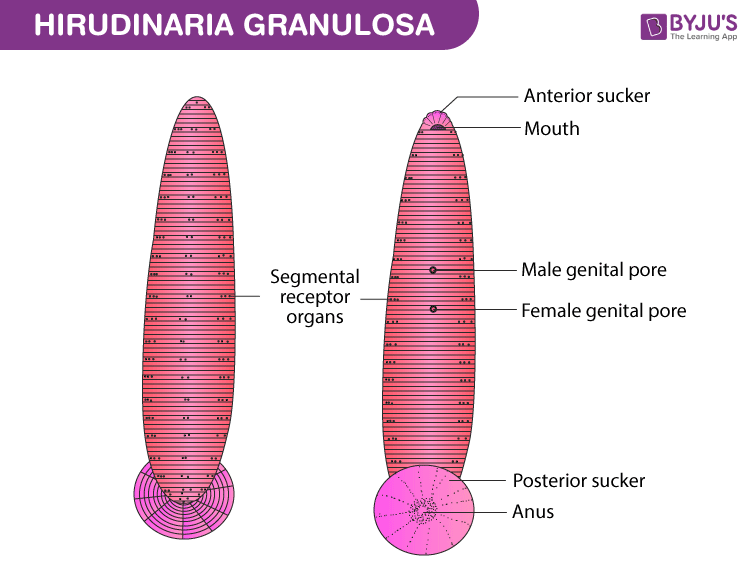Leeches are metamerically segmented parasitic worms. They are annelids and thus have unjointed appendages. The unique feature of leeches is the presence of anterior and posterior suckers.
Let’s look at the description of the leech (Hirudinaria granulosa) with a labelled diagram.
Table of Contents:
- Leech – Classification
- Well-labelled Diagram of Leech (Hirudinaria granulosa)
- Habitat and Distribution
- Description
- Frequently Asked Questions
Leech – Classification
| Kingdom | Animalia |
| Phylum | Annelida |
| Class | Clitellata |
| Order | Gnathobdellida |
| Genus | Hirudinaria |
| Species | granulosa |
Well-labelled Diagram of Leech (Hirudinaria granulosa)

Habitat and Distribution
Hirudinaria or Indian cattle leech is a freshwater species. They are cosmopolitan in distribution but are mostly found in Myanmar and India. They are sanguivorous ectoparasites that live in swamps, slow-running streams, lakes and ponds.
Description
- Leeches have a soft, elongated, dorso-ventrally flattened body that measures approximately 30-35 cms in length.
- Their body is divided metamerically into 33 segments or somites. Each segment is further divided into annuli or rings.
- Their body is divided into six regions – cephalic region ( 1-5 segments), pre-clitellar (6-8), clitellar region (9-11), middle region (12-22), caudal (23-26) and the posterior sucker (27-33).
- The dorsal five segments have 5 pairs of eyes.
- Segmental receptor organs are 3 pairs on the ventral side and 4 pairs on the dorsal side.
- They also have well-developed posterior and anterior suckers.
- The posterior sucker is circular and forms a muscular disc at the rear end. This sucker serves as an organ of adhesion and locomotion.
- The anterior sucker is ventral and oval in shape. It forms a triradiate mouth by the fusion of prostomium and a few anterior segments.
- Nephridia are 17 pairs and are segmentally arranged from the 6th to 22nd segment.
- The alimentary canal is a straight tube placed on the 25th segment.
- Anus is located on the 26th segment.
- Leeches are hermaphrodites. The male genital aperture is present mid-ventrally in the second and third annuli of the 10th segment. The female genital aperture is between the second and third annuli of the 11th segment.
- The male organs include testis sacs, vas efferens, vas deferens, epididymis, ejaculatory ducts and genital atrium. The female organs include the ovaries, oviducts and vagina. Sexual reproduction is common.
Significance
Leeches are parasites that feed on the blood of humans and other animals. Leeches secrete proteins like hirudin that serve as anticoagulants and thus prevent blood from clotting. In earlier days, they were used to draw blood from patients in order to reduce fluid pressure.
Frequently Asked Questions
What are somites?
Somites or metameres are bilaterally paired blocks that are seen along the head to tail axis of segmented animals. It is visible in arthropods and annelids. In leeches, the body is divided metamerically into 33 somites.
What are clitellata?
Clitellata denotes a class of annelid worms that have a unique feature called the clitellum. The clitellum is a thick girdle-like ring present at the anterior end of the body. In leeches and earthworms, it is a thick glandular segment that secretes a viscid sac for the eggs to be stored.
What are hermaphrodite animals?
Hermaphrodites are animals that have both male and female reproductive organs and can produce both gametes.
Also Check:
| Phylum Annelida |
| Difference between Leeches and Bloodsuckers |
| Parasites and Symbiosis |
Keep exploring BYJU’S Biology for more exciting topics.

Comments